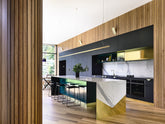Mastering the Art of Jointing: A Guide to Porcelain Slabs Jointing Compound
In the world of luxury surfaces, attention to detail makes all the difference. Whether designing an opulent residential kitchen or specifying finishes for a boutique hospitality space, ensuring a seamless aesthetic is paramount. With the rise of large-format surfaces, the demand for expert application of porcelain slabs jointing compound has never been greater. These jointing materials serve both aesthetic and functional purposes—bonding surfaces with enduring perfection.
At Zicana Boutique, we celebrate craftsmanship at every level, curating only the most exquisite materials, including our renowned Porcelain Slabs Collection. Today, we explore what makes a flawless jointing finish possible and how to select the right compound and application method for unrivaled results.
Why Porcelain Slabs Are the Architects’ Favorite
Porcelain slabs represent the pinnacle of performance and sophistication. Their durability, stain resistance, low porosity, and vast design possibilities make them a go-to choice for luxury countertops, feature walls, fireplace surrounds, and high-traffic flooring.
Available in natural stone textures, concrete looks, and modern matte finishes, these large-format surfaces minimize visible seams. However, when seams must exist (particularly in joined panels or corner applications), choosing the appropriate jointing compound for porcelain slabs becomes integral to achieving the flawless appearance discerning clients expect.
What Is a Porcelain Slabs Jointing Compound?
A porcelain slabs jointing compound is a high-performance filler used to bond and seal joints between two porcelain surfaces. Unlike standard grout or silicone, jointing compounds for porcelain are specially formulated to adhere to dense materials and maintain flexibility as buildings naturally settle or expand.
The right jointing compound matches both in performance and aesthetics—offering seamless integration with your porcelain slab’s design while withstanding environmental elements, UV exposure, moisture, and cleaning routines.
Choosing the Right Jointing Compound: Factors that Matter
When selecting a jointing compound, consider the following elements to ensure optimal performance and visual coherence:
- Color Matching: Jointing compounds are available in a spectrum of shades to complement porcelain veining and base tones. A near-invisible join is essential for projects prioritizing uninterrupted visual lines.
- Elasticity: Flexibility is key for large-panel applications in interior and exterior settings. Look for elastic polymers capable of absorbing minor structural movements.
- Ease of Application: Smooth application reduces labor time and enhances final appearance. Compounds that require minimal tooling and have extended open times are ideal for intricate layout work.
- Thermal and UV Stability: For outdoor cladding or sunlit rooms, choose compounds resistant to fading or cracking over time.
Luxury porcelain lines from Zicana—including the exquisite Raphael Porcelain Collection and architect-beloved Laminam Collection—deserve a jointing solution curated with the same precision.
Preparing for a Seamless Joint: Trade Tips
Whether you’re a contractor, fabricator, or doing a high-end DIY renovation, proper preparation is vital for joint longevity and appearance. Here are essential pre-application guidelines:
- Clean the Surfaces: Remove dust, residue, and oils before applying any compound. Use a neutral pH cleaner compatible with porcelain.
- Allow for Proper Expansion Gaps: Leave joint spaces per manufacturer recommendation (often 1-3 mm). Overly tight joints increase failure risk.
- Use Masking Tape: Protect adjacent areas and control compound line thickness for a precision finish.
- Apply with Confidence: Load a quality caulking gun evenly, smooth immediately with a spatula or finger, and remove excess before curing.
For truly custom spaces, Zicana offers Made-to-Measure Custom Countertops—ensuring jointing needs are accounted for from the very start of your fabrication journey.
Where to Use Porcelain Jointing Compounds
Porcelain slab jointing compound applications span across residential and commercial settings:
- Kitchen countertops and waterfall islands
- Bathroom vanities and shower walls
- Feature walls and TV surrounds
- Floating benches and integrated tables
- Fireplace surrounds—pair with our luxurious Fireplace Collection
Precision jointing elevates each of these applications into a sophisticated, architectural feature. For those creating immersive designer spaces, joint integrity is as important as the material itself.
Zicana Exclusive: Elevate with Offers
At Zicana Boutique, we understand that luxury is not just a material—it’s an experience. Enhance your project planning with our Exclusive Offers Collection, featuring rare stone and porcelain sourced from premium quarries and manufacturers.
Ready to start your next masterpiece? Use Promo Code WELCOME100 for $100 off any order over $1,000—your first step towards unmatched elegance in every slab, joint included.
FAQs: Porcelain Slab Joints Explained
What is the difference between grout and a porcelain slabs jointing compound?
Grout is a cement-based filler commonly used for tile joints, but it lacks the flexibility and specific adhesion properties needed for dense, large-format porcelain slabs. A porcelain slabs jointing compound is an advanced polymer-based filler ideal for high-stress joins in luxury applications.
Can I install porcelain slabs with invisible joints?
While completely invisible seams aren’t always feasible, using a color-matched jointing compound with precise application technique can create a near-seamless look. Choosing slabs with continuous veining, such as those found in our Florim Collection, further enhances the uninterrupted aesthetic.
Is jointing compound waterproof?
Yes, most high-grade jointing compounds are waterproof and mold-resistant, making them ideal for zones like bathrooms, spa rooms, and kitchen backsplashes. Always choose a product specifically rated for wet-area use.
How long does the compound take to cure?
Cure times vary based on compound type and environmental conditions but generally range between 12 to 48 hours. Avoid using the surface until full curing is achieved to ensure long-term joint performance.
Enhance Every Detail with Zicana’s Expertise
Precision is luxury’s closest ally. Whether you’re selecting the ideal porcelain slabs jointing compound or searching for the perfect slab to bring your interior vision to life, Zicana Boutique provides the materials and knowledge to help you achieve perfection. Explore our expansive Porcelain Slabs Collection or consult our design specialists today.
And don’t forget—elevate your first order with our exclusive welcome gift: Use Promo Code WELCOME100 for $100 off any order over $1,000. Your masterpiece awaits.



















